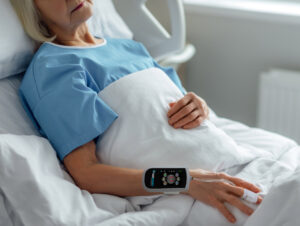
Take steps to improve periop outcomes: The APSF recommendations on perioperative hemodynamic instability
It’s no secret that studies across a wide range of surgical procedures have found that perioperative hemodynamic instability is associated with poor outcomes. Yet, best-practice guidelines for hemodynamic monitoring are still lacking. In December 2023, the Anesthesia Patient Safety Foundation took a step towards addressing this gap with the publication of recommendations for perioperative patients with hemodynamic instability. The paper outlines 17 best practices across 7 domains to help prevent harm from hemodynamic instability. It’s intended to assist clinicians and hospital administrators in designing approaches to care, pursuing quality improvement initiatives and conducting research for future improvement.
In the paper, the APSF acknowledges what we at Caretaker Medical see as a significant problem that needs to be addressed; that the gap between what is and what could be regarding hemodynamic instability is substantial and that patients have a right to healthcare free from harm.
At Caretaker Medical, our mission is to help close that gap with easy-to-use, clinically-effective and cost-efficient wireless hemodynamic monitoring technology. VitalStream, the only FDA-cleared wireless, noninvasive continuous cardiac output and blood pressure monitor, can be leveraged to implement some of the APSF recommendations and in turn, help you provide safer care for your patients.
Leverage VitalStream to help prevent hemodynamic instability-related harm at all phases of care
Patients are at risk for hemodynamic instability throughout all phases of care and postoperative morbidity and mortality is relatively high. Some of the recommendations in Prevent Hemodynamic Instability-Related Harm at All Phases of Care domain include:
- Care should be well integrated with effective handoffs.
- The ability to assess volume responsiveness in the OR using appropriate monitoring.
- The ability to continue monitoring for an extended period in the PACU and other floors to allows for the identification and early treatment of hemodynamic instability.
How VitalStream can help:
VitalStream can easily be used for hemodynamic and vital signs monitoring throughout the entire perioperative continuum. The low-pressure finger sensor can be comfortably worn by conscious patients and its portable form factor allows for uninterrupted and continuous monitoring at all stages of care.
VitalStream also allows you to assess volume responsiveness with the touch of a button using the fluid challenge timer. All you need to do is start and stop the timer. The percent of change calculations are done for you. The easy-to-identify color codes (green for yes, red for no) indicate volume responsiveness.
Leverage VitalStream to aid in data-driven quality improvement
The Data-Driven Quality Improvement domain recognizes that current quality improvement measures have been focused on the intraoperative period, but acknowledges that the postoperative period is also important. The domain recommends that effort should be made to collect data from all types of patients, procedures and treatment areas in order to improve the quality of care.
How VitalStream can help:
As previously discussed, VitalStream can be used throughout the entire perioperative continuum. This enables robust data collection from admission through discharge, and even beyond discharge. Actionable beat-by-beat data is generated and stored for all VitalStream parameters to enable detailed analysis and the development of quality improvement initiatives. The data can also easily be forwarded to a central database or registry.
The importance of technology
Currently, common practice on surgical wards is spot checked vital signs This allows for monitoring blind spots where episodes of hypotension go undetected. The Importance of Technology domain includes recommendations to leverage and improve hemodynamic monitoring technology to enable better detection of instability. This section specifically highlights FDA-approved technologies that continuously and non-invasively monitor blood pressure and continuous cardiac output as a way to detect decompensation earlier and allow for enhanced monitoring during care transitions.
Some of the recommendations in this domain include:
- Fast track new technologies and therapies to accelerate adoption and integration into current practice. Specifically:
- Improve and implement continuous noninvasive monitoring.
- Improve monitors that provide real time feedback to whether an intervention is effective.
- Advance wearable technology.
- Create a wireless agnostic interface between all monitoring systems and EMRs.
How VitalStream can help:
VitalStream the only wireless, wearable monitor that is FDA cleared for continuous blood pressure, cardiac output, stroke volume, heart rate variability and left ventricular ejection time.
VitalStream continuously monitors over 20 vital sign parameters allowing for real-time data and insights and enabling early detection of cardiovascular insufficiency. The system can wirelessly interface with EHRs and monitoring systems and alerts can be set up to align with your facility’s protocols or to meet your patient’s unique needs.
VitalStream marries clinical efficacy with easy-to-use design. It can be fit, calibrated and monitoring within 90 seconds for expedited set-up in preop. The tablet application provides you with a familiar and modern experience that can be quickly learned with minimal instruction. (If you know how to use your smartphone, you know how to use VitalStream.)
Lastly, at Caretaker Medical, we are committed to partnering with out clients to continuously improve our devices. Because of our small size, we don’t have the red tape of larger organizations. This allows us to quickly act on insights and client feedback.
Leverage Vitalstream to follow the APSF recommendations for clinical management
The Recommendations for Clinical Management – Best Practices section outlines several best practices based on current knowledge. It also acknowledges that the current state of clinical practice is primarily focused on diagnosing and treating blood pressure, but that it is often a late indicator of underlying pathology.
Some of the best practices mentioned include:
- Appropriately monitor patients throughout the perioperative period in a reasonably resourced tier fashion.
- High-risk patients may require continuous noninvasive devices that analyze changes in the arterial pressure waveform.
- New technology also provides other data that are derived from waveform analysis (eg, systemic vascular resistance, cardiac output, blood volume and contractility) that help to determine the root cause of hemodynamic instability.
- Disease specific targeted interventions should be made based on the root cause of hemodynamic instability.
How VitalStream can help:
VitalStream is the only hemodynamic monitor that uses a patented physiological model called Pulse Decomposition Analysis (PDA) to analyze the pulse pressure waveform at 500 times per second. Unlike similar noninvasive technologies that use mathematical models, PDA provides insight into what is actually happening within a patient’s body, not what is statistically predicted to happen, and accounts for vascular tone making it accurate with patients on pressors. PDA looks at the pulse reflection behaviors of the aorta and there is no need to enter height. weight, age and gender unless you want to calculate indices.
VitalStream also provides the continuous measurement of over 20 parameters arming you with the information needed to determine the root cause of hemodynamic instability and provide safer care for your patients.
More medical news and events

Caretaker Medical Receives Inaugural Healthcare Tech Innovation Award and $200,000 Grant from Medical Society of D.C.
WASHINGTON, DC, UNITED STATES, April 2, 2025 /EINPresswire.com/ -Caretaker Medical is honored to announce it has been awarded the Healthcare Technology Innovation Award, along with…

Caretaker Medical Awarded the Grand Prize in NIH RADx Tech for Maternal Health Challenge
Caretaker Medical, a digital health company focused on developing hemodynamic monitoring devices, today announced that it has been awarded the $525,000 grand prize in the…

VitalStream offers continuous hemodynamic monitoring solution amid IV fluid shortage
Philadelphia, PA – October 9, 2024 – Caretaker Medical, a pioneer in advanced hemodynamic monitoring technology, is highlighting the critical role of its VitalStream solution…
